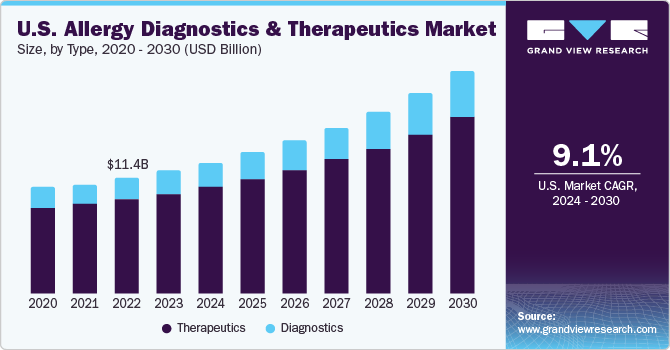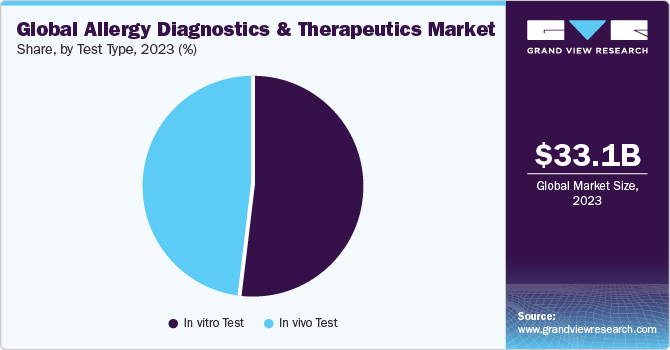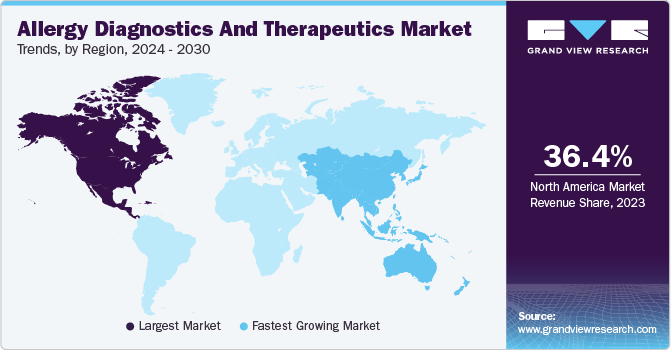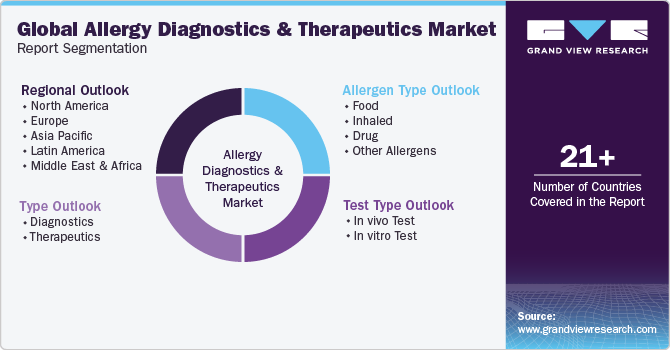- Home
- »
- Pharmaceuticals
- »
-
Allergy Diagnostics And Therapeutics Market Report, 2030GVR Report cover
![Allergy Diagnostics And Therapeutics Market Size, Share & Trends Report]()
Allergy Diagnostics And Therapeutics Market Size, Share & Trends Analysis Report By Type (Diagnostics, Therapeutics), By Allergen Type (Food, Inhaled, Drug), By Test Type, By Region, And Segment Forecasts, 2024 - 2030
- Report ID: 978-1-68038-701-8
- Number of Report Pages: 150
- Format: PDF, Horizon Databook
- Historical Range: 2018 - 2022
- Forecast Period: 2024 - 2030
- Industry: Healthcare
Market Size & Trends
The global allergy diagnostics and therapeutics market size was estimated at USD 33.06 billion in 2023 and is projected to grow at a compound annual growth rate (CAGR) of 8.7% from 2024 to 2030. Some major factors driving the market growth are rising prevalence of allergy disorders in children & geriatric population, increasing adoption of IVD techniques, and improving access to diagnostic tools in developing countries of Asia Pacific region. Furthermore, changing lifestyles, growing pollution, unhealthy habits, such as smoking; and urbanization are some of the key factors contributing to the increasing incidence of allergic conditions. Introduction of therapeutically advanced drugs such as immunotherapy drugs can solve unmet patient needs, which is expected to boost market growth over the forecast period.

Increasing incidence of allergies is one of the key factors contributing to allergy therapeutics market growth. Rising exposure to outdoor and indoor air pollutants and occupational exposure are among high-risk factors causing chronic respiratory diseases. Prevalence of allergies is much higher in the urban population compared to rural due to rising exposure to environmental pollutants due to industrial activities and urbanization.
According to statistics published by the World Health Organization (WHO) in January 2023, around 1 in 4 children and 1 in 3 adults have a seasonal allergy in the U.S. Nearly 6% of children and adults in the U.S. suffer from a food allergy with the rate being highest among black, Asian, and Hispanic individuals. Similarly, as per data from the Asthma and Allergy Foundation of America, in 2021, in the U.S., about 81 million people were diagnosed with seasonal allergic rhinitis, representing around 26% affected adults and 19% affected children.
Increasing demand for IVD testing is expected to boost the allergy diagnostics and therapeutics market over the forecast period. In vitro blood tests are used to determine various types of allergies such as food, inhaled, skin, and drug allergies. These tests have various benefits, such as the fact that they are minimally invasive and are cost-effective & user-friendly, which is anticipated to create lucrative growth opportunities in this market. In addition, the development of low-cost and effective in vitro diagnostic tests for allergy determination, rising lab automation, and an increase in reagent rental agreements are some of the factors expected to contribute to market growth in the coming years.
Market Dynamics
Increase in funding is driving advancements in research, development, and accessibility of innovative therapies, addressing the growing demand for more effective treatments & management strategies. This heightened financial support is propelling the growth of the peanut allergy treatment market, fostering the development of safer and more accessible solutions for those affected by this condition. For instance, in December 2022, Aravax, a clinical-stage biotechnology company, initiated its series B funding round with a substantial USD 20 million investment from prominent Australian life science investors, Brandon Capital and Tenmile.
This funding will empower Aravax to begin Phase 2 trials of PVX108 and seek additional capital to expedite its development efforts. Having received approval for its Investigational New Drug (IND) application from the U.S. FDA and a clinical trial notification from Australia's TGA, Aravax is set to progress its Phase 2 clinical trial program across the U.S. and Australia.
However, key drugs in the space such as Nestlé's Palforzia faced significant challenges. Despite a substantial investment of USD 2.6 billion in its development, the treatment regimen proved to be too cumbersome for many potential patients. Even after 3 years, many physicians have not prescribed Palforzia. Across the U.S., doctors & patients are opting for the traditional approach of avoiding peanuts and carrying adrenaline injections for emergencies instead.
Similarly, according to a recent survey published by the European Medicine Agency in September 2023, the adoption of Palforzia in European region is lower than the expected post drug launch. As a significant development in the market, Nestlé divested its Palforzia business in September 2023 to Stallergenes Greer, a biopharmaceutical company specializing in allergy diagnosis and treatment. This strategic move followed Nestlé's earlier announcement of a review of Palforzia, with Nestlé set to receive milestone payments and ongoing royalties from Stallergenes Greer as part of the agreement.
Type Insights
On the basis of type, the market is segmented into therapeutics and diagnostics. The therapeutics segment held the largest revenue share of over 81.67% in 2023 due to its focus on treating allergic conditions. Therapeutics aim to alleviate symptoms and provide relief from allergies, addressing the core concern of patients. Epinephrine dominated the overall market owing to its rapid and potent response as well as its swift action during severe allergic reactions, such as anaphylaxis. As a natural hormone, it mimics body's fight-or-flight response, swiftly alleviating symptoms such as respiratory distress and low blood pressure. Its ubiquity, cost-effectiveness, and decades-long established use contribute to its dominance, making it a crucial and trusted tool in emergency allergy management.
Diagnostic segment is anticipated to witness the fastest CAGR over the forecast period due to increasing demand for precise and early identification of allergic conditions. Diagnostics are pivotal in evaluating allergen sensitivities, enabling targeted therapeutic interventions.
The consumables segment held the largest revenue share in 2023 and is anticipated to grow at a significant CAGR due to its indispensable applications in diagnostic tests. Associated benefits such as availability of kits specific to each allergen and ease of access are expected to fuel this segment’s growth during the forecast period. For instance, Allergen microarray kits, which have become more sensitive and provide individualized patient assessment & monitoring, are expected to propel the industry even further.
Allergen Type Insights
Based on allergy type, the inhaled segment held the largest revenue share of over 49.68% in 2023 owing to the growing incidence of respiratory allergies caused by industrialization and increasing air pollution. According to estimates published by the Allergy and Asthma Foundation of America, seasonal allergic rhinitis was expected to affect approximately 81 million people in the U.S. by 2021. This corresponded to approximately 26% (67 million) of adults & 19% (14 million) of minors, and this number is expected to grow over the forecast period. Hence, increasing incidence of allergic rhinitis is expected to present future growth opportunities for market growth.
Drug allergies are expected to experience a faster CAGR over the coming years. Drug allergies may lead to toxic epidermal necrolysis and Steven-Johnson syndrome in children. Chemotherapy drugs, sulfonamide drugs, and antiepileptic drugs are the most common agents of drug allergies. These allergens lead to various diseases such as contact dermatitis, which is skin inflammation. The segment is expected to showcase positive growth during the coming years due to increasing availability of treatment options and growing awareness about drug allergies among patients.
Test Type Insights
In vitro test segment held a market share of 51.54% in 2023. This test is utilized for identifying allergen-specific immunoglobulin E. (IgE). Serum IgE has a higher positive predictive value and better specificity for detecting aeroallergen (pollen & insect) sensitization. These factors can significantly impact allergy diagnostics market penetration during the forecast period. Furthermore, food allergy is a growing public health concern, with rising rates in both developed & developing nations. For example, according to Food Allergy Research and Education's 2022 statistics, approximately 2.8 million Americans are anticipated to have egg allergy in 2020 while 2.5 million will have wheat allergy.

In vivo test segment is estimated to grow at a significant CAGR over the forecast period. This is attributed to increasing adoption of several in vivo tests having convenient, cost-effective, safe & reliable properties than that of others. Growing demand for rapid, simple, and efficient testing has fueled the growth of in vivo diagnostic tests. These tests look at the susceptibility and reactivity of dermal mast cells, which can indicate allergic sensitivity. To ensure reliability, these procedures include skin exams with standardized allergenic extracts.
Regional Insights
North America market is the leading region with a revenue share of 36.44% in 2023 owing to factors such as rising incidences of allergy and favorable government initiatives in the region. North America is a developed region with high healthcare expenditure. The region held a major market share due to an increased understanding of the high potential associated with allergy drugs. This has driven U.S.-based firms to make considerable investments in the development of these drugs. Moreover, new players are entering the market with their novel products, which is expected to intensify competitive rivalry in North America market.

Asia Pacific market is anticipated to grow at a lucrative rate owing to various factors, such as increasing healthcare reforms and expanding healthcare infrastructure. Other factors contributing to the market growth are growing population, rising incidence of allergies, and increasing number of local companies entering the market. Asia Pacific, with Japan, China, and India being notable markets in this region, is projected to boost the market within the region. Key players in these countries are undertaking various strategic initiatives to increase their dominance in the market. For instance, in October 2022, Siemens Healthineers divided Asia Pacific into two regions (China and the rest of Asia Pacific) to achieve its full potential in the region.
Key Companies & Market Share Insights
The allergy diagnostics & therapeutics industry is highly competitive and market players are involved in activities such as strategic collaborations, new product launches, acquisitions, technological advancements, and regional expansion.
-
In October 2023, Astria Therapeutics, Inc announced a license agreement with Inchon’s Sciences. The agreement covers the OX40 portfolio, particularly focusing on development of STAR-0310 for potential treatment of atopic dermatitis (AD) and other allergic and immunological diseases.
-
In January 2023, ALK received FDA approval for expanded use of ODACTRA, a sublingual immunotherapy tablet in the treatment of house dust mite-induced allergic rhinitis for adolescents aged 12 through 17.
-
In October 2022, Allergy Partners collaborated with Aimmune Therapeutics to offer direct access to PALFORZIA, an FDA-approved peanut allergy treatment, to patients aged 4-17. PALFORZIA will be provided through Allergy Partners Therapeutics (APT) across its national network.
-
In August 2022, Thermo Fisher Scientific's ImmunoCAP blood tests for identifying wheat & sesame allergies have been approved by the FDA. According to the company, in vitro diagnostic tests, which detect specific antibodies, can differentiate between wheat sensitization & grass cross-reactivity and help many patients avoid unnecessary dietary restrictions.
Key Allergy Diagnostics And Therapeutics Companies:
- R-Biopharm AG
- Thermo Fisher Scientific, Inc.
- DASIT Group SPA
- EUROIMMUN Medizinische Labordiagnostika AG (PerkinElmer, Inc.)
- AESKU.GROUP GmbH
- bioMérieux
- Siemens Healthcare GmbH
- Stallergenes Greer
- HYCOR Biomedical
- Minaris Medical America, Inc.
- Omega Diagnostics Group PLC
- Lincoln Diagnostics, Inc.
- HOB Biotech Group Corp., Ltd.
- Danaher
- Alcon
- AbbVie, Inc.
- Sanofi
- Allergy Therapeutics
- Pfizer, Inc.
- Teva Pharmaceutical Industries Ltd.
- GSK plc
- Sun Pharmaceutical Industries Ltd
- F. Hoffmann-La Roche Ltd.
- Merck & Co., Inc.
- Astellas Pharma Inc.
- Epigenomics AG
Allergy Diagnostics And Therapeutics Market Report Scope
Report Attribute
Details
Market size value in 2024
USD 35.27 billion
Revenue forecast in 2030
USD 58.31 billion
Growth rate
CAGR of 8.7% from 2024 to 2030
Base year for estimation
2023
Historical data
2018 - 2022
Forecast period
2024 - 2030
Quantitative units
Revenue in USD million/billion and CAGR from 2024 to 2030
Report coverage
Revenue forecast, company ranking, competitive landscape, growth factors, and trends
Segments covered
Type, allergen type, test type, region
Regional scope
North America; Europe; Asia Pacific; Latin America; MEA
Country scope
U.S.; Canada; Germany; U.K.; France; Italy; Spain; Denmark; Sweden; Norway; China; Japan; India; Australia; Thailand, South Korea; Brazil; Mexico; Argentina; South Africa; Saudi Arabia; UAE; Kuwait
Key companies profiled
R-Biopharm AG; EUROIMMUN Medizinische Labordiagnostika AG (PerkinElmer; Inc.); DASIT Group SPA; AESKU.GROUP GmbH; bioMérieux; Thermo Fisher Scientific, Inc.; Stallergenes Greer; Minaris Medical America, Inc.; Siemens Healthcare GmbH; Omega Diagnostics Group PLC; HYCOR Biomedical; Lincoln Diagnostics, Inc.; Alcon; HOB Biotech Group Corp., Ltd.; Danaher; AbbVie, Inc.; Allergy Therapeutics; Sanofi; Pfizer, Inc.; Teva Pharmaceutical Industries Ltd.; Sun Pharmaceutical Industries Ltd; GSK plc; F. Hoffmann-La Roche Ltd.; Merck & Co., Inc.; Astellas Pharma Inc.; Epigenomics AG
Customization scope
Free report customization (equivalent up to 8 analyst’s working days) with purchase. Addition or alteration to country, regional & segment scope
Pricing and purchase options
Avail customized purchase options to meet your exact research needs. Explore purchase options
Global Allergy Diagnostics And Therapeutics Market Report Segmentation
This report forecasts revenue growth and provides an analysis on the latest trends in each of the sub-segments from 2018 to 2030. For this study, Grand View Research has segmented the global allergy diagnostics & therapeutics market report on the basis of type, allergen type, test type, and region:

-
Type Outlook (Revenue, USD Million, 2018 - 2030)
-
Diagnostics
-
Instruments
-
Consumables
-
Services
-
-
Therapeutics
-
Antihistamines
-
Decongestants
-
Corticosteroids
-
Mast Cell Stabilizers
-
Leukotriene Inhibitors
-
Nasal Anti-cholinergic
-
Immuno-modulators
-
Epinephrine
-
Immunotherapy
-
-
-
Allergen Type Outlook (Revenue, USD Million, 2018 - 2030)
-
Food
-
Dairy Products
-
Poultry Product
-
Tree Nuts
-
Peanuts
-
Shellfish
-
Wheat
-
Soys
-
Other Food Allergens
-
-
Inhaled
-
Drug
-
Other Allergens
-
-
Test Type Outlook (Revenue, USD Million, 2018 - 2030)
-
In vivo Test
-
Skin Prick Test
-
Intradermal Test
-
Patch Test
-
-
In vitro Test
-
-
Regional Outlook (Revenue, USD Million, 2018- 2030)
-
North America
-
U.S.
-
Canada
-
-
Europe
-
Germany
-
U.K.
-
France
-
Italy
-
Spain
-
Denmark
-
Sweden
-
Norway
-
-
Asia Pacific
-
Japan
-
China
-
India
-
Australia
-
South Korea
-
Thailand
-
-
Latin America
-
Brazil
-
Mexico
-
Argentina
-
-
Middle East and Africa (MEA)
-
South Africa
-
Saudi Arabia
-
UAE
-
Kuwait
-
-
Frequently Asked Questions About This Report
b. The global allergy diagnostics and therapeutics market size was estimated at USD 33.06 billion in 2023 and is expected to reach USD 35.27 billion in 2024.
b. The global allergy diagnostics and therapeutics market is expected to grow at a compound annual growth rate of 8.7% from 2024 to 2030 to reach USD 58.31 billion by 2030.
b. North America dominated the allergy diagnostics and therapeutics market with a share of 36.44% in 2023. This is attributable to high incidence of respiratory allergic disorders along with rising awareness levels about allergy diagnostics and adoption of in vitro blood tests.
b. Some key players operating in the allergy diagnostics and therapeutics market include bioMerieux, Thermo Fisher Scientific, Danaher Corporation, Omega Diagnostics, Hitachi Chemical Diagnostics, Stallergenes Greer, Siemens Healthcare, Lincoln Diagnostics, Hycor Biomedical, HOB Biotech Group, and Alcon Laboratories.
b. Key factors driving the allergy diagnostics and therapeutics market growth include increasing incidences of allergy diseases; increasing demand for IVD tests for allergy diagnosis; and growing healthcare expenditure triggering development of effective allergy diagnostic & therapeutic products.
Share this report with your colleague or friend.
![gvr icn]()
NEED A CUSTOM REPORT?
We can customize every report - free of charge - including purchasing stand-alone sections or country-level reports, as well as offer affordable discounts for start-ups & universities. Contact us now
![Certified Icon]()
We are GDPR and CCPA compliant! Your transaction & personal information is safe and secure. For more details, please read our privacy policy.
We are committed towards customer satisfaction, and quality service.
"The quality of research they have done for us has been excellent."





